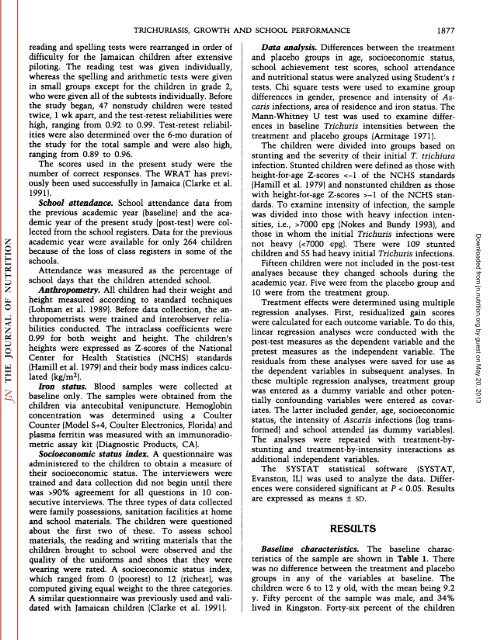Treatment of Trichuris trichiura Infections Improves Growth, Spelling ...
Treatment of Trichuris trichiura Infections Improves Growth, Spelling ...
Treatment of Trichuris trichiura Infections Improves Growth, Spelling ...
Create successful ePaper yourself
Turn your PDF publications into a flip-book with our unique Google optimized e-Paper software.
eading and spelling tests were rearranged in order <strong>of</strong><br />
difficulty for the Jamaican children after extensive<br />
piloting. The reading test was given individually,<br />
whereas the spelling and arithmetic tests were given<br />
in small groups except for the children in grade 2,<br />
who were given all <strong>of</strong> the subtests individually. Before<br />
the study began, 47 nonstudy children were tested<br />
twice, 1 wk apart, and the test-retest reliabilities were<br />
high, ranging from 0.92 to 0.99. Test-retest reliabil<br />
ities were also determined over the 6-mo duration <strong>of</strong><br />
the study for the total sample and were also high,<br />
ranging from 0.89 to 0.96.<br />
The scores used in the present study were the<br />
number <strong>of</strong> correct responses. The WRAT has previ<br />
ously been used successfully in Jamaica (Clarke et al.<br />
1991).<br />
School attendance. School attendance data from<br />
the previous academic year (baseline) and the aca<br />
demic year <strong>of</strong> the present study (post-test) were col<br />
lected from the school registers. Data for the previous<br />
academic year were available for only 264 children<br />
because <strong>of</strong> the loss <strong>of</strong> class registers in some <strong>of</strong> the<br />
schools.<br />
Attendance was measured as the percentage <strong>of</strong><br />
school days that the children attended school.<br />
Anthropometry. All children had their weight and<br />
height measured according to standard techniques<br />
(Lohman et al. 1989). Before data collection, the anthropometrists<br />
were trained and interobserver relia<br />
bilities conducted. The intraclass coefficients were<br />
0.99 for both weight and height. The children's<br />
heights were expressed as Z-scores <strong>of</strong> the National<br />
Center for Health Statistics (NCHS) standards<br />
(Hamill et al. 1979) and their body mass indices calcu<br />
lated (kg/m2).<br />
Iron status. Blood samples were collected at<br />
baseline only. The samples were obtained from the<br />
children via antecubital venipuncture. Hemoglobin<br />
concentration was determined using a Coulter<br />
Counter (Model S+4, Coulter Electronics, Florida) and<br />
plasma ferritin was measured with an immunoradiometric<br />
assay kit (Diagnostic Products, CA).<br />
Socioeconomic status index. A questionnaire was<br />
administered to the children to obtain a measure <strong>of</strong><br />
their socioeconomic status. The interviewers were<br />
trained and data collection did not begin until there<br />
was >90% agreement for all questions in 10 con<br />
secutive interviews. The three types <strong>of</strong> data collected<br />
were family possessions, sanitation facilities at home<br />
and school materials. The children were questioned<br />
about the first two <strong>of</strong> these. To assess school<br />
materials, the reading and writing materials that the<br />
children brought to school were observed and the<br />
quality <strong>of</strong> the uniforms and shoes that they were<br />
wearing were rated. A socioeconomic status index,<br />
which ranged from 0 (poorest) to 12 (richest), was<br />
computed giving equal weight to the three categories.<br />
A similar questionnaire was previously used and vali<br />
dated with Jamaican children (Clarke et al. 1991).<br />
TRICHURIASIS, GROWTH AND SCHOOL PERFORMANCE 1877<br />
Data analysis. Differences between the treatment<br />
and placebo groups in age, socioeconomic status,<br />
school achievement test scores, school attendance<br />
and nutritional status were analyzed using Student's i<br />
tests. Chi square tests were used to examine group<br />
differences in gender, presence and intensity <strong>of</strong> As<br />
caris infections, area <strong>of</strong> residence and iron status. The<br />
Mann-Whitney U test was used to examine differ<br />
ences in baseline <strong>Trichuris</strong> intensities between the<br />
treatment and placebo groups (Armitage 1971).<br />
The children were divided into groups based on<br />
stunting and the severity <strong>of</strong> their initial T. <strong>trichiura</strong><br />
infection. Stunted children were defined as those with<br />
height-for-age Z-scores -l <strong>of</strong> the NCHS stan<br />
dards. To examine intensity <strong>of</strong> infection, the sample<br />
was divided into those with heavy infection inten<br />
sities, i.e., >7000 epg (Nokes and Bundy 1993), and<br />
those in whom the initial <strong>Trichuris</strong> infections were<br />
not heavy (
















